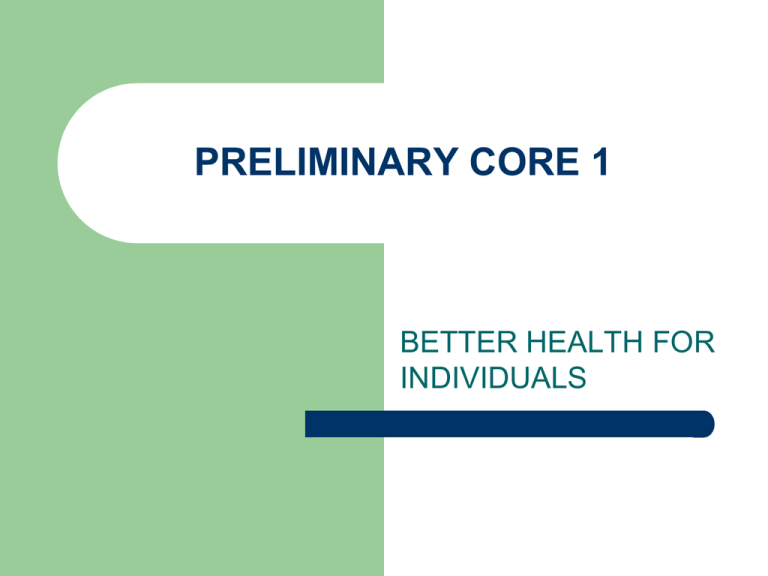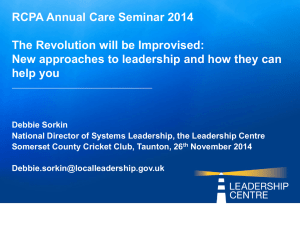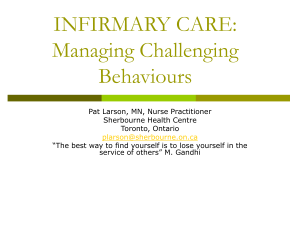
PRELIMINARY CORE 1
BETTER HEALTH FOR
INDIVIDUALS
What does health mean to individuals?
Meanings of health
- Definitions of health
INQUIRY
Complete the following questions:
Good health to me means…
The signs of being healthy are…
To lead a healthy lifestyle you need to…
Definitions of Health
500bc Ancient Greek medical writer
Alcmaeon
“the equal and cooperative mingling of the
separate elements of human nature”
1913 Webster’s Dictionary
“the state of being hale, sound, or whole, in
body, mind, or soul; especially, the state of
being free from physical disease or pain”
World Health Organisation (WHO)
Defined health as:
“a state of complete, physical, mental, and
social well-being and not merely the absence
of disease or infirmity”
Greater recognition to a more holistic concept
of health by recognising the whole person.
Dimensions of health
It is now widely recognised that there is a
relationship between a person’s body, mind
and spirit.
-
- Dimensions of health
SPIRITUAL
PHYSICAL
HEALTH
MENTAL
OR
EMOTIONAL
SOCIAL
INQUIRY
Recall a time in your life when 1 dimension of
your life was poor. Consider how other
dimensions of your health were also affected
during this time. Draw a mind map to
illustrate your answer.
- Relative and dynamic nature of health
Health is a continually changing process.
Represented as a continuum.
Judging where you see yourself on the
continuum at any time is subjective.
Are you as healthy as an Olympic athlete?
Relative
Refers to how we judge our health compared
to other people or other points of time in our
life.
Example – a person with bipolar may
consider themselves well when they are
taking medication, treatment and are able to
fulfill work and personal responsibilities,
compared to how they felt prior to diagnosis
and treatment.
Dynamic
Refers to the constant fluctuations that occur
in our level of health.
Our health fluctuates minute to minute, day
to day and year to year. Illness, accident,
environmental factors can change our level
of health many times during our life. These
changes mean that health is dynamic.
Identify what determines an individuals
health.
•Perceptions of health
View the following pictures and honestly
comment on how you would perceive their
health
1. Homeless
2. Snow boarder
3. Family
4. Aboriginal
5. Elderly road sign
- Personal perceptions of health.
The way we perceive our own health is highly
subjective and influenced by a wide range of factors:
- Our behaviours and lifestyle
- Environment
- Personal interpretation of health
- Beliefs about achieving good health
- Our past level of health
- Attitudes about health conveyed by the media, peers
and family
- Personal values
How healthy do others think I am?
Pick someone in the class.
Using a 5 point scale (excellent, very good,
good, fair, poor) rate what you think their
current level of health is and explain why.
Do the same for yourself.
Compare results.
- Perceptions of the health of others
Australians are generally healthy and their
health continues to improve, however, there
are many factors that contribute to health
inequalities:
Age, gender, disabilities, etc
Due to socio economic difference
- Implications of different perceptions
of health
INDIVIDUAL LEVEL
People develop their own interpretation of
what being healthy means and perceive
levels of health differently.
Eg.
Implications of perceptions of
health
POLICY LEVEL
Different perceptions drives the agenda for agencies
responsible for developing health strategies
(interventions, policies, resources)
Awareness of these different perceptions guides
public health intervention (campaigns, programs)
Conflicting perceptions arise about the areas of
health that should be given the highest priority.
- Perceptions of health as social
constructs.
So what is it that shapes our perceptions?
Our views on good health and who possesses it are
influenced by social, economic and cultural
conditions of family/society.
Social construct is a concept that recognises that
people have different views based on their social
circumstances and ways of seeing, interpreting,
interrelating and interacting with their environment.
Mind map sheet
DETERMINANTS OF HEALTH
Socioeconomic Status (SES)
Linked to income, education, employment & housing.
People with low ses generally have poorer health.
They also perceive their health as fair/poor and feel
less in control of their destiny.
They have different expectations about their health
potential.
Less money to spend on positive health behaviours,
they have more dangerous jobs, lower standard of
living environment & less access to health care for a
variety of reasons.
Therefore it is likely that they will develop different
meanings of health to those of high SES.
Geographic location
Divided into urban, rural and remote.
Varying social constructs due to unique features of
location.
Rural/remote = poor access to health services and
recreational activities. They consult GP less. They
also have harsher living environment and less
exposed to health promotion and self care.
These differences affect the perceptions of health
formed by people living in remote areas, as well as
how they assess their current state of health.
Cultural background
Ethnic population groups (i.e. Aboriginal people) have vastly
different meaning for health. Their emphasis on spiritual
dimension is greater.
Example – traditional healers to care for the sick
Differences in beliefs and attitudes about health that are
conveyed from one generation to another, can see perceptions
of health take on different meanings within some cultural
groups.
Dominant cultures have greater social power – Anglo saxon
urban group – judged on physical health.
Mainstream medicines, drugs and surgery
Alternate medicines are gaining more respect as our perception
on health changes.
- Impact of the media, peers and family
MEDIA
Main forms are:
Raises awareness
Might cause a dominant focus at the expense of others.
Heightens peoples perceptions of the risk due to the severity of
the illness/disease.
Can contribute to misconceptions (body image)
Heightened public concern can pressure government
policies/health expenditure.
E.g. introduction of laws relating to zero BAC.
PEERS
Most likely to influence our ideas/behaviours
in terms of health.
Positive –
Negative -
FAMILY
Parents = role model
Their perception of health is passed on.
Example SES is a major factor. Living in a low SE
environment can impact on the ideas young people
develop.
Caring for chronically ill family has implications:
When we view health as a social
construct it allows us to:
~ explain why people behave in
different ways
~ understand social norms are
established in cultural subgroups
~our concept of health can take on
different meanings in particular
social contexts.
•Health behaviours of young people
This topic is frequently discussed in the
media.
Examples:
Do young people have poor health?
- The positive health status of young
people.
Research into health status/outcomes is regularly under taken
by the Australian Institute of Health and Welfare (AIHW)
AIHW report – “Young Australians: their health and well being
2007”
12-24 yrs old
Improved over time
“faring well in terms of health and well-being”
Improvements in life expectancy
Decline in mortality (1980-2004) caused from injury, suicide
and transport accidents
Reductions in morbidity from chronic illness, communicable
disease, injury and suicide.
Figure 2.29
1.
2.
3.
Analysing mortality rates of young people.
Propose reasons for the decline in mortality rates of
young people over the last 20 years.
What are some of the strategies and initiatives that
were implemented during this time that may have
contributed to the fall in death rates?
Explain reasons for the difference in the death
rates of young males to females
Self assessment
Nearly 70% young people - rated their own
health as excellent.
However, significant differences were evident
in the health of young Australians who are:
Indigenous
Living in rural or remote areas
Experiencing low socioeconomic
disadvantage.
Inquiry
Examine the information on the following
page comparing the death rates of different
groups of young people in Australia.
Write a paragraph describing the differences
between the various groups. Include in your
paragraph possible reasons for the
differences that are evident from the table.
Indigenous Australians
Young indigenous Australians were less likely
to perceive their health as excellent.
Life expectancy is lower. 20 yrs less.
Chronic illness – higher rates of asthma,
diabetes and injury
Risk factors – obesity, tobacco, incarceration
and lower levels of education.
Living in remote areas.
Injuries
Poisoning
High risk drinking
Poor diet
Specific health conditions of concern
for young people.
Mental health disorders
Greatest contributor to the burden of disease.
Those experiencing high levels of distress are
increasing.
Injuries
The leading cause of ill health, hospitalisation and
death in this age group
2/3 of premature deaths in this age group. 3x higher
for males.
- Protective behaviours and risk
behaviours.
Protective behaviours – are those health behaviours
that are likely to enhance a person’s level of health.
E.g. eating adequate amounts of fruit and vegetables
daily.
Risk behaviours – are those health behaviours that
have been found to contribute to the development of
health problems or poorer levels of health.
E.g. Smoking
Behaviours relating to physical activity
Young people – 60 mins mod/vigorous exercise daily
(recommended)
Benefit – stronger bones/muscles. Joint flexibility, friendships, <
stress. Less chance to develop illness in later life (type 2
diabetes)
Trend – 2004-05 National health survey
Less active with age.
46% males, 30% females meet recommendations.
High school age – ¾ boys, 2/3 girls, +2hrs on electronic
entertainment.
Risk Factors – Sedentary lifestyle
Behaviours relating to healthy eating
26% young people consumed +3 fruit/veg daily
47% consumed 3 servings daily
25% high school aged students ate snacks 5
times/week
High energy diet = weight gain/poor dental health.
Presences of indicators of chronic disease, e.g.
elevated levels of insulin in year 10 students(20%).
Risk Factors – skipping meals.
Behaviours relating to body weight
Overweight or obese = health problems.
Short term = affect social and emotional wellbeing.
Long term = cancers, osteoarthritis.
15-24 yrs. Overweight = 24% boys, 15%
females. Obese = 6% boys, 7% girls.
Risk Factors – poor diet, no exercise
Behaviours relating to drug use
Young people experiment with drugs
Smoking, drinking alcohol and illicit drug use.
Smoking – data indicates reduction in smoking among young
people. Suggesting a reduction in tobacco related illness in
future.
Alcohol – in excess is the problem. Binge drinking = poisoning.
Reduces inhibition which can cause physical and emotional harm.
E.g.
28% females, 24% males = drink high level of risk.
Illicit drug use (cannabis 13% within the last 12 months,
amphetamines, heroin)
Psychological harm e.g depression
Behaviours relating to sexual activity
Short/long term risks.
Unsafe sex = STI’s (chlamydia/gonorrhoea), pregnancy
(premature babies, lower birth weight, unfinished schooling,
etc)
PB – being ready for the consequences of a sexual relationship
(emotional/physical).
- effective contraception
- pap smears
RB - casual sex/ multiple partners. 25% had sex while drunk.
Some young people reported being affected by drugs had
contributed to their involvement in unwanted sex.
- 10% of sexually active people were not using any form of
contraception.
Behaviours relating to establishing
social networks and support
Connectedness – sense of belonging or attachment towards
other people and places they are frequently in contact with.
Resilience is the capacity of individuals to deal with adversity
and challenges in ways that make it possible for them to lead a
healthy and fulfilling lives.
Not “fitting in” can experience loneliness and alienation. Higher
rates of depression.
PB – regularly attending school, church, team sports, voluntary
work.
RB – not doing the above.
10% of young people felt they had no one to seek support from.
Behaviours relating to safety
Road Crashes – leading cause of death and injury
for young people. 30% = transport.
2007 RTA analysis reported 20% of all
drivers/motorcyclists in fatal crashes were aged
between 17-25, however, this group only accounted
for 15% of all license holders.
Risk taking behaviours - speeding, drinking,
identifying hazards, fatigue.
Other distractions – mobile phone, passengers,
music.
Behaviours relating to accessing help.
Education - knowing protective/risk behaviours
enabling the person to make “healthier” decisions.
Studies have shown that young people’s knowledge
of health issues is poor.
E.G Sexual health survey – less than 20% of young
people knew that Chlamydia was the most common.
RB – Not seeking help when needed, particularly,
mental health issues.
Concerns about confidentiality and embarrassment.
The effect of multiple protective or risk
behaviours
Certain behaviours are often associated with each other which
increases the health risks to young people.
E.g. National survey of Australian secondary students and
sexual health 2002 found that unwanted sex was most
commonly associated with excessive drinking.
Adolescences experiencing distress, report higher rates of drug
use.
The presences of multiple health risk behaviours increases the
level of harm
E.g.
The interaction of multiple protective behaviours can reduce the
health risk
E.g.
Inquiry
Think about the factors that affect the health
of young people. E.g. drug use, road use.
Predict how risk decreases or increases
when multiple factors interact.
Create a scenario to discuss.








